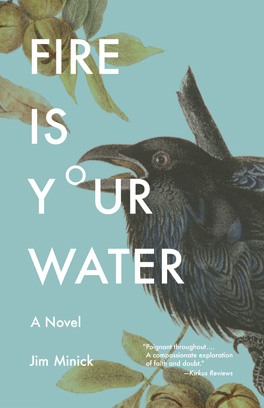Fire is Your Water by Jim Minick. Swallow Press, $26.95
Fire is Your Water by Jim Minick is a novel that may present several hurdles over which the fresh reader must initially jump. First, the setting—”Pennsylvania Dutch” communities in the 1950s—may not seem important or relevant to many, except perhaps from a historical or cultural perspective. Second, the word powwow—which seems more appropriate to American Indian cultures than to a novel set among the Pennsylvania Dutch—will make some uncomfortable, as though the term were being somehow misappropriated or misused (though in fact, the word’s lineage is far older and far closer to the original Narragansett term here than it is when describing modern tribal gatherings). And third, the elements of magic realism in the work—specifically having a raven as a sentient, central character—will strike some as nothing more than an overt literary gimmick. But, if the reader can successfully move past these hurdles early on, the result will be a reading experience that is both rich and rewarding, an honest exploration of what it means to heal (physically, emotionally, and spiritually) and what it means to have faith (in God and in each other).
The novel is set in 1953 Pennsylvania, specifically the Pennsylvania Dutch communities of the southeastern and south central part of the state. The story centers on Ada, a young woman from a traditional family who is a “braucher,” a practitioner of the powwowing tradition of spiritual faith healing. The novel opens with her family’s barn burning to the ground and the family desperately trying to save as many animals as possible. As a result of this traumatic event, Ada believes she has lost her power to heal. Why? Because for the first time in her life, she “fears death” and “doubts God’s power.”
Another main character is Will Burke, a young man who works at the Esso station next to the Howard Johnson’s where Ada is working part-time. He’s something of a rogue—not at all religious, but very kindhearted. So much so that he takes in and heals a wounded raven he names Cicero. He and Ada embark on a friendship that turns into much more during the course of the novel. Other characters include Aunt Amanda, a mentor and spiritual guide for Ada, Uncle Mark, a fellow healer, as well as an array of other relatives and community characters who people this richly drawn rural landscape.
It’s a place familiar to Minick, whose family comes from there, and upon whose stories he relied in this, his first work of fiction. Not that he hasn’t written of similar places and characters before. Prior to Fire is Your Water, Minick wrote two books of poetry, a collection of essays, and a memoir titled The Blueberry Years: A Memoir of Farm and Family. He holds an MFA from UNC-Greensboro and is currently an Assistant Professor of English at Augusta University, as well as one of the core faculty at Converse College’s low-residency MFA program.
Though this is his first novel, it’s clear from the beginning that Minick is no novice. His command of language, and more importantly, his command of imagery, is sophisticated without being overly stylized and profound without the grandstanding and high drama that many first-time novelists display. Minick’s images grow naturally from the time, the place, and the people, from their own stories, their own mythologies, and their own history.
The most notable image in the novel is, of course, fire. Actual fires punctuate the text—most notably at the beginning and the end—but fire imagery is everywhere. Ada describes her hands as “burning” when they are engaged in healing; life itself is often described in terms of heat and fire. In Cicero the Raven’s first segment, he recites the Cherokee story of how ravens became black—trying to capture fire and bring it back to mankind, portraying himself as a sort of failed Prometheus figure. Here, as is often the case, fire represents change and transformation—the natural magic of something becoming something else, something becoming what it was meant to be all along. We see this in the story of the raven, but more importantly, we see this in the character of Ada, and later Will. Eventually, we see this in the very fabric of the community itself.
Faith is another important idea in the novel, the faith that comes from absolute trust. This sort of faith is, in many ways, an anathema to conscious thought, as Ada learns. Deep faith, the kind that fuels healing, requires absolute trust—in God, in other people—and without it, no true healing or transformation can take place. However, faith fully realized can spark miracles, as Will eventually learns after his accident. What’s interesting here is the way Minick interweaves faith as a religious concept and faith as a source of power in the folk traditions and in the cultural lore, conflating all needs (physical, emotional, spiritual) that such power can address. In fact, “brauchen” in German means “to need,” and the novel explores ways that faith in all its forms serves as the source of religious power, generally, as well as being the source of the powwower’s healing arts, specifically.
One unique aspect of the novel are the elements of magic realism, the actions that circumvent logic or provide coherence on a larger plain. This can especially be explored with the character of Cicero, Will’s raven friend who provides commentary throughout the novel and acts as a counterpoint to man’s efforts to control nature and control himself. Cicero is a no-nonsense bird, a trickster figure with a keen eye for deception and things that ring falsely. His sometimes vulgar vernacular stands in sharp contrast to the language you hear in the community, or in the third person narration (Cicero’s sections are first person). But his observations are accurate and telling, as though his position outside the human world gives him special insight. His voice begins the novel and ends it, but more than being a feathered “Greek chorus” (as one comment described him), Cicero provides not only the frame through which we view the story, he also demonstrates the sensibility we as readers should bring to it.
The title of the novel comes from the poem “The Question” by Rumi, a 13th-century Sufi mystic Persian poet. The poem is about religious fervor and the presence of God on Earth. “Fire,” he writes, “is what of God is world-consuming,” contrasted with water, which is “world-protecting.” However, “if you are a friend of God, fire is your water.” In this novel, finding God, finding faith, means burning away those worldly ideas, worldly things that get in the way and embracing the fire itself, which Minick equates with love, as we see illustrated in the final scene.
Fire is Your Water is an entertaining book on many levels. You can read it as social commentary or as an exploration of an interesting subculture in American society. You can read it as a love story. But if you see only these dimensions, you’re likely to miss its profound underpinnings. This is not a novel about a specific time or place, so much as it’s a novel about the nature of love, what it means to have faith, and ultimately, what it means to be those flawed beings that we call human—creatures that, in the end, earn Cicero’s grudging respect. In the context of Minick’s novel, that is no small achievement. ☐



